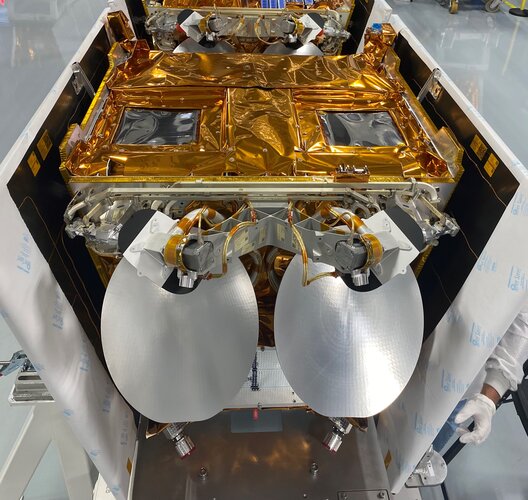
Copernical Team
SpaceX deploys 23 Starlink satellites in first launch for new Falcon 9 booster
 SpaceX successfully launched 23 Starlink satellites from Florida in the first launch of its new Falcon 9 booster.
SpaceX confirmed early Wednesday that the satellites were deployed into low-Earth orbit before the booster landed on a SpaceX drone ship positioned in the Atlantic Ocean.
The mission was slated for Monday, but the rocket auto-aborted two minutes and 28 seconds before
SpaceX successfully launched 23 Starlink satellites from Florida in the first launch of its new Falcon 9 booster.
SpaceX confirmed early Wednesday that the satellites were deployed into low-Earth orbit before the booster landed on a SpaceX drone ship positioned in the Atlantic Ocean.
The mission was slated for Monday, but the rocket auto-aborted two minutes and 28 seconds before NASA's Mars Perseverance snaps a selfie as a Martian dust devil blows by
This request seems a bit unusual, so we need to confirm that you're human. Please press and hold the button until it turns completely green. Thank you for your cooperation!
Press and hold the button
If you believe this is an error, please contact our support team.
185.132.36.159 : 0792fd5b-b2d6-435b-8dce-3b3e066a
Ready for space travel? GENESTAR can track how space affects your health
This request seems a bit unusual, so we need to confirm that you're human. Please press and hold the button until it turns completely green. Thank you for your cooperation!
Press and hold the button
If you believe this is an error, please contact our support team.
185.132.36.159 : e73c8dae-4663-4f48-9426-485827d0
Building a giant catcher's mitt on the moon
This request seems a bit unusual, so we need to confirm that you're human. Please press and hold the button until it turns completely green. Thank you for your cooperation!
Press and hold the button
If you believe this is an error, please contact our support team.
185.132.36.159 : 8be9ca0a-0f8d-47bc-ba8e-1ec61239
A CubeSat propulsion system to visit near Earth objects
This request seems a bit unusual, so we need to confirm that you're human. Please press and hold the button until it turns completely green. Thank you for your cooperation!
Press and hold the button
If you believe this is an error, please contact our support team.
185.132.36.159 : c8ca0cb2-12fa-4e03-aeb4-05078b14
Rice engineers develop resonant energy system for more efficient solar desalination
 Rice University researchers have introduced a novel desalination technology designed to enhance the efficiency and adaptability of solar-powered water purification. The new system, described in a study published in Nature Water, leverages a resonant energy transfer approach that overcomes the intermittency of sunlight, a common limitation in conventional solar desalination systems.
Unlike
Rice University researchers have introduced a novel desalination technology designed to enhance the efficiency and adaptability of solar-powered water purification. The new system, described in a study published in Nature Water, leverages a resonant energy transfer approach that overcomes the intermittency of sunlight, a common limitation in conventional solar desalination systems.
Unlike NASA X-59's Latest Testing Milestone: Simulating Flight from the Ground
 NASA's X-59 quiet supersonic research aircraft successfully completed a critical series of tests in which the airplane was put through its paces for cruising high above the California desert - all without ever leaving the ground.
"The idea behind these tests is to command the airplane's subsystems and flight computer to function as if it is flying," said Yohan Lin, the X-59's lead avionics
NASA's X-59 quiet supersonic research aircraft successfully completed a critical series of tests in which the airplane was put through its paces for cruising high above the California desert - all without ever leaving the ground.
"The idea behind these tests is to command the airplane's subsystems and flight computer to function as if it is flying," said Yohan Lin, the X-59's lead avionics Beam-hopping JoeySat marks two years in orbit

An innovative satellite that offers reliable connectivity wherever and whenever it is needed – in crowded places such as summer festivals as well as following passengers in planes, trains and automobiles – has celebrated its second anniversary in space.
Skynet 6A reaches integration milestone as Airbus prepares next-gen military satellite
 The UK's Skynet 6A military communications satellite has completed the integration of its communications and service modules, marking a key step toward deployment. Built by Airbus at its Stevenage and Portsmouth sites, the satellite achieved this milestone at the National Satellite Test Facility (NSTF) in Harwell, Oxfordshire, which is managed by RAL Space under the Science and Technology Facili
The UK's Skynet 6A military communications satellite has completed the integration of its communications and service modules, marking a key step toward deployment. Built by Airbus at its Stevenage and Portsmouth sites, the satellite achieved this milestone at the National Satellite Test Facility (NSTF) in Harwell, Oxfordshire, which is managed by RAL Space under the Science and Technology Facili Second CubeSat added to ESAs Ramses mission for close study of Apophis
 ESA is expanding its Ramses mission to asteroid Apophis with the addition of a second CubeSat, further enhancing scientific efforts to study the asteroid during its extremely close approach to Earth on April 13, 2029. Apophis, measuring 375 meters across, will pass Earth at a remarkably close distance, offering a rare opportunity for in-depth observation.
The Ramses mission, which could be
ESA is expanding its Ramses mission to asteroid Apophis with the addition of a second CubeSat, further enhancing scientific efforts to study the asteroid during its extremely close approach to Earth on April 13, 2029. Apophis, measuring 375 meters across, will pass Earth at a remarkably close distance, offering a rare opportunity for in-depth observation.
The Ramses mission, which could be 
